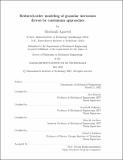Reduced-order modeling of granular intrusions driven by continuum approaches
Author(s)
Agarwal, Shashank
DownloadThesis PDF (18.93Mb)
Advisor
Kamrin, Ken
McKinley, Gareth H.
van Rees, Wim M.
Goldman, Daniel I.
Terms of use
Metadata
Show full item recordAbstract
Granular intrusions such as ballistic impacts, vehicular and animal locomotion in natural terrains, and stirring of materials in industrial processes are common. Granular media often exhibits coupled solid-like and fluid-like multiphase characteristics in such systems that are commonly not shown by simple solids (like metals) and fluids (like water). This makes modeling granular media challenging. While the field of granular physics extensively uses grain-scale Discrete Elements Modeling (DEM) to model such characteristics of granular systems, they are computationally expensive. On the other hand, capabilities to model such systems in real-time are critical in numerous applications such as path planning and efficient maneuvering of vehicles in sandy terrains on earth and extra-terrestrial environments. Due to their shape-and media-specific forms, existing reduced-order intrusion modeling methods have limited capabilities.
This work focuses on developing efficient approaches to model motions of arbitrarily shaped objects into the granular volumes to various numerical details and accuracy levels. Specifically, we focus on a mesoscale continuum approach and a macroscale empirical approach. We establish the sufficiency of appropriately-chosen constitutive laws and computational methods in modeling various complex granular flow scenarios with a continuum approach. We exploit the approach to develop deep insights into the origin of granular resistive forces encountered during granular intrusions. We further use these insights to extend an empirical modeling method called Resistive Force Theory (RFTs) for real-time modeling of granular intrusions. RFTs developed in this work are verified against a variety of experimental and simulation results and allow modeling the motions of arbitrary three-dimensional objects moving arbitrarily in granular media at low and high speeds in real-time.
Date issued
2022-05Department
Massachusetts Institute of Technology. Department of Mechanical EngineeringPublisher
Massachusetts Institute of Technology